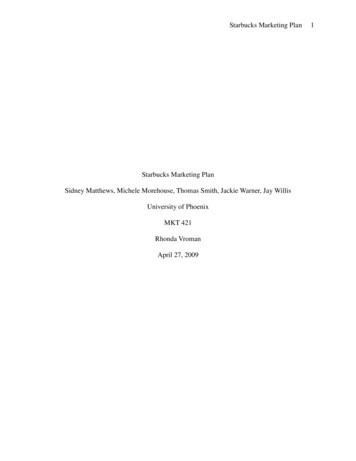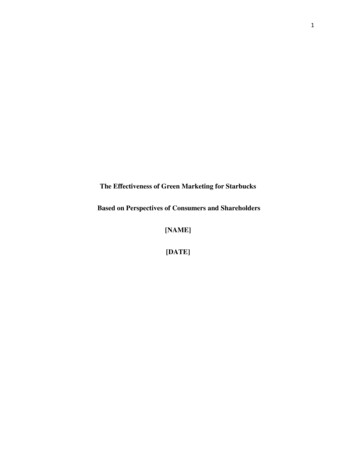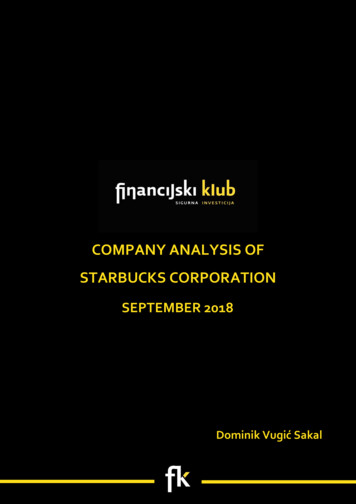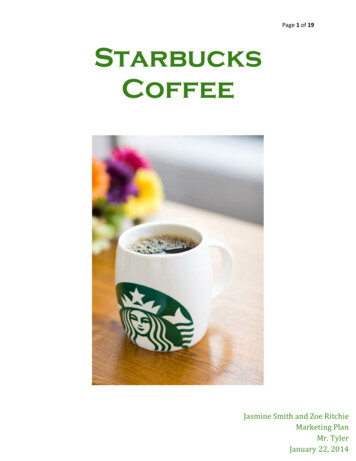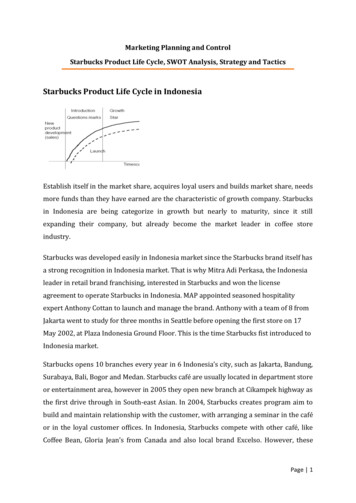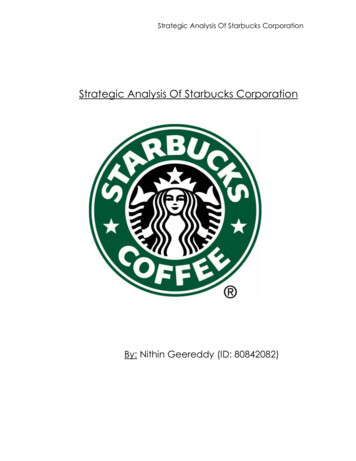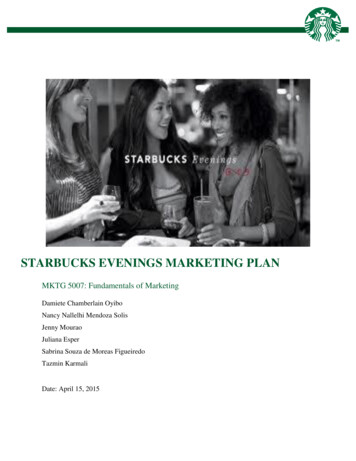
Transcription
STARBUCKS EVENINGS MARKETING PLANMKTG 5007: Fundamentals of MarketingDamiete Chamberlain OyiboNancy Nallelhi Mendoza SolisJenny MouraoJuliana EsperSabrina Souza de Moreas FigueiredoTazmin KarmaliDate: April 15, 2015
Contents1.STARBUCKS’ OVERVIEW . 22.PRODUCT OFFERING AND CHANNEL STRATEGY . 33.SITUATION ANALYSIS . 33.1 SWOT. 33.1.1 Strengths . 33.1.2 Weakness . 43.1.3 Opportunity. 43.1.4 Threats . 53.2PORTER 5 FORCES . 53.2.1 New market entrants: Low . 53.2.2 Bargaining power of buyers: Medium to High . 63.2.3 Bargaining power of supplier: Medium to High Pressure . 63.2.4 Threat from substitutes: High . 63.2.5 Rivalry among existing players: High . 64.MARKET OVERVIEW AND TARGET MARKET . 75. MARKETING OBJECTIVES AND STRATEGY . 76. MISSION STATEMENT. 87. MARKETING MIX AND MARKETING OBJECTIVES . 98. FINANCIAL ANALYSIS . 119. CONTINGENCY PLAN . 14Works Cited . 151
1. STARBUCKS’ OVERVIEWStarbucks is a leading retailer of specialty coffee, with over 21,000 retail locations in 66 countries (StarbucksCompany Profile, 2015). Today, along with high-quality coffees, the company also sells tea and other beverages, a varietyof fresh food items and packaged food goods. The first Starbucks location was established in 1971 in Seattle, Washington,United States and expanded to Canada in 1987 in Vancouver, B.C. With just under 40 Starbucks locations per one millionpeople in Canada, Starbucks has a far reach that exceeds even that in the U.S. per capita (Babad, 2014).Starbucks’ strategy has always been to differentiate itself from the typical coffee shop by providing each customerwith a unique Starbucks Experience. The Starbucks Experience is built upon superior customer service, maintaining storesthat reflect the personality of the communities in which they operate and building a high degree of customer loyalty(Starbucks Annual Report, 2014). Howard Schultz, the company President and CEO, defined the atmosphere in Starbucksas “creating communities in the third place between home and work” (Larkin, 2015).Starbucks focuses on five criteria that define the company’s work - handcrafted, artistic, sophisticated, human, andenduring (Millman, 2011). With an emphasis on quality, the Starbucks brand has become one of the most recognized andrespected brands in the world and the company’s main objective is to maintain this status (Starbucks Annual Report, 2014).The company’s current strategy to achieve this is through a continued global expansion of its store base as well asdiversifying its product mix (Starbucks Annual Report, 2014). It has become increasingly important for Starbucks to branchinto different markets due to stagnant coffee sales (Wright, 2015). In Canada, Starbucks occupies the third positon in marketshare of coffee retailers, after Tim Hortons and McDonalds (with the introduction of McCafé). Starbucks sales in 2013totaled over 900 million (Euromonitor International, 2014). One of the new concepts that the company has introduced isStarbucks Evenings, a program in which select Starbucks locations will serve wine and beer alongside a small menu ofshareable plates in an evening ambiance.2
2. PRODUCT OFFERING AND CHANNEL STRATEGYThe Starbucks Evening program, which initially launched in Seattle, Washington in October 2010, consists of amenu of wine and beer as well as a selection of a few light, savory bites available after 4pm (Franson, 2014). The wineoptions are available by the glass or bottle and the beer is sold in bottles only. In the U.S., the wine menu varies by locationand offers a mix of local and international wines from both small and large wineries. In keeping in line with the chain’srecent shift to steer away from a generic “cookie cutter” brand (Wright, Starbucks drinks in local flavour, 2014), this sameformula for selecting a mix of local and international wines should be adhered to when the program is introduced intoCanada.The Starbucks Evenings program also commands certain premium details to enhance the high-end feel of the menu.The food items are served on elegant flatware and with silverware instead of plastic utensils, wine is served in contemporarystem-less goblets and beer is served in custom glassware (Friend, 2012). Starbucks Evenings locations are also selling thewine goblets which are branded with the Starbucks name printed with a selection of four unique phrases on them. The wineglasses are manufactured by Riedel, a high-end brand of glassware (Riedel Wine Glasses at Starbucks, 2012).While employees at Starbucks Evenings locations will now have to meet provincial laws regarding alcohol service(i.e. In Ontario must be at least 18 years of age and have Smart Serve certification), guests of all ages are still welcome atall hours. As with regular orders at the store locations, food and beverage orders during the Starbucks Evenings are alsoplaced with the barista, unlike full restaurant service. The regular coffee menu is also still available during the evenings.Starbucks employs a system of relationships with suppliers to provide their snacks and pastries in their stores. Thecompany’s locations do not have full restaurant style kitchens and are not equipped to do more than brew coffee. This wasa deliberate move by the company’s CEO Howard Schultz who banned in-store baking in order to keep the smell of thecoffee “pure” (Misonzhnik, 2013). The same strategy can be adopted in the Starbucks Evenings program where strategicrelationships are set up with key suppliers to provide the stores with the food available at Starbucks Evenings while keepingthe authentic smell which is an important component of the Starbucks brand (White, 2013).3.SITUATION ANALYSIS3.1 SWOT3.1.1 Strengths Location: With just under 40 Starbucks locations per one million people in Canada, Starbucks has a reach that farexceeds even the USA (The Huffington Post Canada, 2014). Starbucks Evenings introduction into the Canadianmarket would benefit from this extensive reach.3
Customer loyalty: Starbucks has developed and maintained a devout customer base which they can pull from. Itwould not be hard to convince customers who are already in Starbucks as part of their normal routine to try out theStarbucks Evenings menu. Diversity of product offerings: Starbucks as a leader in the coffee industry already has experience in diversifyingtheir offerings. The company is known for its eclectic product options, allowing customers to tailor their drinks totheir liking. Starbucks Evenings is another way to add to that diversity of product by naturally progressing into adifferent line of business. Strong Brand: The Starbucks brand is one of the most recognized in the world - synonymous with quality. Thebrand plays on the ideas of the five filters such as handcrafted, artistic, sophisticated, human, and enduring(Millman, 2011). Starbucks Evenings still tightly intertwines with the Starbucks brand by going back to the originalglobal campaign of “Meet me at Starbucks” (Interbrand, 2014). Starbucks Experience: The Starbucks brand is more than coffee, there is a relaxed atmosphere associated with thebrand and this can be translated into the Starbucks Evenings service. The design of Starbucks is deliberate to makecustomers comfortable by fostering interaction and enticing customers to stay (Larkin, 2015).3.1.2 Weakness Strong brand: Starbucks first and foremost is a coffee brand. The company’s strong brand identity might act as adeterrent to its plans for diversification. Demographic: Starbucks Evenings identified target audience are women, aiming to appeal about 60% of theirpopulation (Wright, 2015). This would lead to an exclusion of a still large demographic of men and those customerswho are underage. Starbucks has not had reason to apply purchasing age restrictions at their stores, and this mightprove a challenge to enforce.3.1.3 Opportunity Untapped market: Starbucks Evenings presents an opportunity for Starbucks to take advantage of an untappedmarket. While cafes serving alcohol have been widely popular in Europe and around the world for some time, thishas not yet taken off in Canada. Starbucks has always been a pioneer in catering to the customer’s needs. Forexample, Starbucks was one of the first stores where customers can go in and specialize their coffee order (Durham,2007) this order process has been copied by other coffee brands worldwide. Now Starbucks can be a market leaderby establishing Starbucks Evenings service. The Starbucks Evenings program would increase its market reach by including non-coffee drinkers in its clientele.Allowing the company to compete on a stronger base. Studies have also shown that coffee sales usually peak anddecline at a certain point in the day. The study showed that 65% of all coffee is consumed during breakfast hours,4
30% between meals, and the remaining 5% with other meals (E-imports, 2015). Allowing the company competethroughout the day instead of just in the mornings when coffee drinking is predominant. Personality behind service: The Starbucks brand is known for its unique personality injected into their services.There is an opportunity for the uniqueness to be transferred into the Starbucks Evenings services. StarbucksEvenings’ partnership with Reidel Glass Company is a great opportunity for Starbucks to offer continuity in theirpersonalization service. They could also provide opportunities for customers to purchase these glasses incorporatingthe same marketing strategy that exists with the sales of the Starbucks coffee cups (StarbucksMelody.com, 2012). Opportunity to expand to have Starbucks Evenings as standalone shops where the times can be expanded. At themoment Starbucks Evenings is being introduced as part of the company’s products depth, being available in thesame locations that have regular Starbucks services there is an opportunity for Starbucks to eventually create a subband which operates separately from the Starbucks coffee shops allowing them to extend their business hours fromthe proposed start time of 4pm and accommodate early users.3.1.4 Threats Brand Dilution – Starbucks started off as a coffee shop and it has built its brand to be one of luxury in coffee.Starbucks has moved from the traditional coffee shop but most of its growth in variety has been in the same realmof business, for example, Starbucks introducing products like Products like Evolution fresh juices and La Boulangefood (Interbrand, 2014), is still closely related to the Starbucks brand. Venturing from non-alcoholic drinks to winesand beers is a transition that a few would struggle with. Cannibalization: There also exists the threat of cannibalization of Starbucks Evenings become the morerecognizable brand and people waiting until 4pm in order to go into a Starbucks, there by taking over their initialproducts in their minds.3.2 PORTER 5 FORCES3.2.1 New market entrants: Low The threat to Starbucks as a new entrants is not that high. Starbucks has the advantage of already being the in quick serve industry, the company w
15.04.2015 · Starbucks’ strategy has always been to differentiate itself from the typical coffee shop by providing each customer with a unique Starbucks Experience. The Starbucks Experience is built upon superior customer service, maintaining stores that reflect the personality of the communities in which they operate and building a high degree of customer loyalty (Starbucks Annual Report, 2014). Howard .
